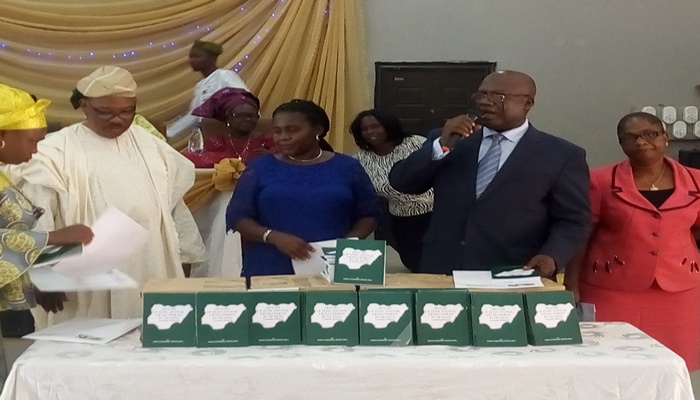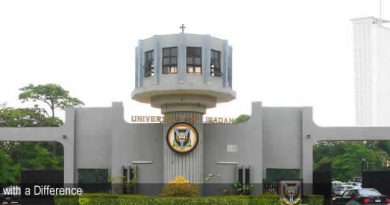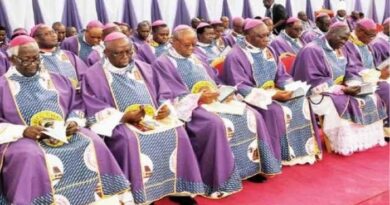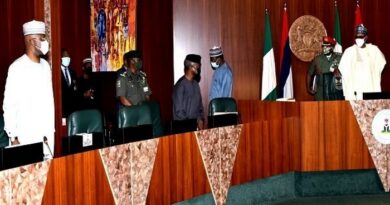History of Educational Development in Nigeria
By Mrs Eniola Adigun
When you pick a copy of the book that is being launched today by Mrs. Eniola Adigun, and you look at the title HISTORY OF EDUCATIONAL DEVELOPMENT IN NIGERIA, what comes to your mind, if you are within my age bracket, is: what does she want to say about the History of Educational Development in Nigeria that Prof. Babs Fafunwa has not said. In fact, what does she want to write about Education itself that Fafunwa or Fajana has not written? Though this kind of biased mind set can affect your enthusiasm to read the book, remember the saying, “Never judge a book by its cover”. Mrs. Adigun has done a brilliant job in her own little way to ensure that between Fafunwa’s and her own generations, the History of Educational Development in Nigeria does not suffer any lacuna.
While stating her objective for writing book, the author explains: “The urge to write this book was born from my interaction and experience with my students over the years. These students tend to see History of Education as uninteresting, too difficult and sometimes boring. This attitude of disinterest often results in poor performance and sometimes in failure”.
The other aspects of the objective which the author does not state explicitly as she has done to the first one, is the fact that the details, event, facts and data of History relating to Education in Nigeria must continue to be preserved, recycled, refreshed, re-preserved, re-produced, re-enacted if the present generation and future generations are not to suffer or recline into historical amnesia as a result of the failure of the older generations to transfer knowledge in its entirely.
Though the book contains only 174 pages, it is comprehensive enough for students of Education as it covers almost all the fundamental issues on education and its history in Nigeria. For instance, from cheaper one to chapter six, the author explains the goals and philosophy of Education in Nigeria and the key elements of education. She then goes on to define History and its significance to education in Nigeria. Before dissecting Education in Nigeria during Colonial era, the author discusses the trajectory of Education in Nigeria from traditional or indigenous education, to Islamic Education and Christian Missionary or Western Education. Extolling the virtue or value of indigenous or traditional education, the author submits that “traditional education stabilized the society for it inculcates loyalty, courage, respect for tradition, obedience and discipline into the young ones growing up in the society. She also reiterates that indigenous education helped to transmit cultural heritage, norms, customs and beliefs. Echoing one Awoniyi, the author observes that Nigerian traditional education involved the individual as well as his society, for what affects one affects the whole. The goals of the society, according to the author, become the goals of the individual and vice versa. Even when the individual offends the customs and taboos of his society, steps are taken to appease the gods and get such a recalcitrant man cleansed of his behavior.
However, the coming of Islam into West Africa as early as the 8th century posed a serious threat to indigenous education in Nigeria. This was because Islamic education was introduced by Islamic organizations like Ahmaddiya, Ansar-Ud-Deen and Zumaratu Islamiyah. These bodies established Islamic Schools with the aim of spreading Islam through the reading of the Qur’an, spreading the Arab culture since Islam was seen as a “way of life”, promoting economic activities through trade and commerce.
Despite the fact that Islamic Education became an integral part of education in Northern Nigeria with its attendant merits, it was discovered that Islamic Education has its inadequate which could not make it a model for the kind of Western Education that the Christian missions later introduced into Nigeria. The first Christian mission to introduce western education to Nigeria was the Wesleyan mission which arrived around 1842 and established a school in Badagry in 1843. The Church Missionary Society (CMS) also arrived in Nigeria to open a school in Badagry also in 1845. They were the ones who started the idea of having separate schools for male and female. The Roman Catholic Mission did not come until 1856 and ended up establishing St. Gregory’s College in 1876.
Generally, the aim of these various missions was to convert the pagans and win souls for Christ. The purpose for doing this was to ensure that the converts were literate enough to read the Bible and related literatures, in other words, to make them effective Christians. The Christian or western educational system was well organized in that it had an administrative structure, the use of time-table-table, laid down procedure for the employment of teachers and admissions of students.
In explaining the role played by the Colonial Government in Nigeria’s Educational Development between 1842 and 1960, the author confirms that between 1842 and 1870, the colonial government showed little interest in western education because it was pre occupied with pacifying those areas which offered resistance to British role and areas where troubles broke out in addition, the colonial government and the various missions (except the Southern Baptists Convention) were all British and so the government did not perceive any threat to their policies from the missionaries. Thus between 1870 and 1881, the government gradually departed from its initial posture and began to give small irregular grants to the three main missions. The most significant change, according to the author, in the government’s attitude took place in 1882 when it passed an Education ordinance under which legal provision was made to give grants in-aid to the missions engaged in education. What was paramount was that the ordinances laid the legal foundation of Nigeria education and it also served as the basis for subsequent ordinances and laws. It was under the Ordinances that a general Board of education was established while an inspector of schools for the whole of West Africa was to be appointed. Furthermore, it should be noted that as at 1882, the colony of Lagos was being administered as part of the Gold Coast Colony and it was therefore imperative that with the separation of the colony of Lagos. This was the situation until a new ordinance was made in 1926 based on the Phelps-Stokes Commission Report and the 1925 Memorandum on Education Policy in British Tropical Africa.
In appraising Education Development in Nigeria since 1960, the author recollects that the whole process started on the eve of independence when the Ashby Commission was constituted. To a large extent, the Ashby Commission has been regarded as the first comprehensive appraisal of Education in Nigeria because its immediate responsibility was to come up with a philosophy of Education for Nigeria which it did in 1969 based on the recommendations of “The National Conference on Curriculum Development” which was held in Lagos in 1969.
This resulted in a National Policy on Education in 1977. The new policy spelt out clearly government’s policy vis-à-vis education in Nigeria the implementation of the New national Policy on Education was indeed the introduction of the 6-3-3-4 system of Education decades ago to replace the old system “the British Model” i.e 6-5-2-2 system. In a periscope analysis of the rot in the education system of the country, the author discusses professionalism, curriculum implementation, education inequality, frequent changes in governmental policies, indiscipline in schools, student’s unrest, lack of adequate provision of Guidance and Counseling Service. The aspect of Drug Abuse does not escape the attention of the author. Likewise, the author spends much time to analyze examination malpractices and the issue of cultism in our schools.
In conclusion, I want to say that it was a god effort by the author. I will however point out some errors which I think should be corrected in subsequent editions.
First, in Chapter 5, where the author discusses Islamic Education in Nigeria, she writes that Islam had been firmly established in Northern Nigeria by the end of the 15th century while it got to the Yoruba land towards the close of the 18th century. But while still talking about Islamic Education in Chapter Six which is devoted to “Christian Missionary/Western Education in Nigeria”, the author writes that Islamic education had its impact on Nigeria Education from around the 14th century to the present day. What should we believe? The author should help to make this clear in subsequent editions. In additions to this, I think the issues of Drug Abuse and examination malpractices should also have been handled historically. We are not told when the issue of drug and drug abuse started in our schools. It is also disappointing that nothing is mentioned about the Sogbetun tribunal on examination malpractices that was set up by the Obasanjo administration in 1978. Though the author attributes the origin of cultism and secret cults in our schools to Prof. Wole Soyinka’s national Association of Seadogs founded in 1953 at the University of Ibadan, I don’t think Prof. Soyinka will feel comfortable with the aspersion because I am aware that he has always denied or frowned at this linkage because he does not even agree with the view that his National Association of seadogs founded in 1953 at the University of Ibadan, I don’t think Prof. Soyinka will feel comfortable with this aspersion because I am aware that he has always denied or frowned at this linkage because he does not even agree with the view that his National Association of seadogs was a secret cult.
Some sentences need to be recast for grammatical convenience and linguistic harmony. For instance, on page 34, the author writes the goals of the society becomes the goals of the individual. This should be corrected in subsequent editions. The sentences should read like this: the goals of the society become the goals of the individual. One page 54, also there were no inspectors to check not checks the teaching. Some printers’ devil should also be corrected. On page 47, the Western influence should read Western influence on page 52, it should be intimidate pupils not intimate pupils.
As a historian, I am satisfied that all the details and facts that I need to know about education development in Nigeria have been sufficiently discussed in this book. I therefore recommend it to all students of History and education Development in Nigeria.
Thank you and God bless you for listening.
Dapo Thomas, Ph.D
Picture caption:
From left to right- Sir Herbert H.A Adewole Agbebiyi (father of the day); celebrant/author, Dean Eniola Olajumoke Adigun; representative of the Lagos State Governor, Dr. Shamsideen Allison, Permanent Secretary, Office of the Special Adviser on Education, lastly, representative of the Chairman of the occasion, Prof. (Mrs.) Cecilia Oladapo, HOD: Adult Education, Faculty of Education, Unilag.




